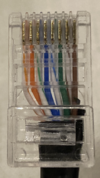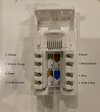I'm running an external Ethernet cable half way round my son's house to improve the office internet speed.
Testing it with a length of internal cable running through the house improved matters considerably.
When it arrives in the office what's the best thing to connect the cable to ?
I'm working on the assumption it's better to connect the external cable once, rather than it flitting from lap top to XBox etc.
When the cable comes through the wall it won't have the end attached.
I have a RJ45 end and a crimping tool ready if required.
I have a new router that could be used as a slave - if it's a good idea?
Or what about an Ethernet wall plate with multiple outlets.
Thank you
Ray
Testing it with a length of internal cable running through the house improved matters considerably.
When it arrives in the office what's the best thing to connect the cable to ?
I'm working on the assumption it's better to connect the external cable once, rather than it flitting from lap top to XBox etc.
When the cable comes through the wall it won't have the end attached.
I have a RJ45 end and a crimping tool ready if required.
I have a new router that could be used as a slave - if it's a good idea?
Or what about an Ethernet wall plate with multiple outlets.
Thank you
Ray





